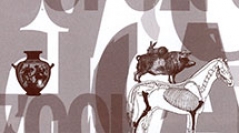

 Anthropozoologica
47 (1) - Pages 291-314
Anthropozoologica
47 (1) - Pages 291-314The radiated and lion-headed snake, designated by the name Chnoubis or Chnoumis, is one of the familiar figures of magical gems dating to the Roman imperial period. Different traditions - medical, astrological, relating to the quality of stones - attribute to this creature various therapeutic competences (against stomach troubles, for the protection of the uterus). This paper reviews the iconography of Chnoubis/Chnoumis which appears on different types of stones, often of a round shape, and examines the meaning and function of the so-called “Chnoubis sign”, a triple S with a horizontal stroke in the middle, often associated wirth the snake. We also review the different hypotheses relating to the origin of the figure, especially its relationship with Kenmet, the first decan of the lion, the primordial god Kematef (Kmeph), the ram-god Khnum and solar deities, as well as with other snakes like the Agathodaimon. This survey allows us to suggest how a decanic entity became a powerful solar deity, associated with the God of Israel, whose popularity survived Antiquity.
Gems, Magic, Decans, Chnoubis, Astrology, Melothesia, Medicine.